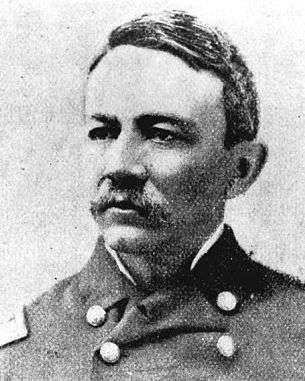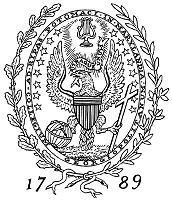Patrick Francis Healy
| Patrick Francis Healy, S.J. | |
|---|---|
 | |
| 29th President of Georgetown University | |
|
In office 1874–1882 | |
| Preceded by | Rev. John Early, S.J. |
| Succeeded by | Rev. James A. Doonan, S.J. |
| Personal details | |
| Born |
February 27, 1834 Macon, Georgia |
| Died | January 10, 1910 (aged 75) |
| Resting place | Jesuit Community Cemetery |
Patrick Francis Healy (February 27, 1834 – January 10, 1910) was a Jesuit priest, educator, and the 29th President of Georgetown University (1874–1882), known for expanding the school following the American Civil War. Healy Hall was constructed during Healy's tenure and is named after him. It was designated as a National Historic Landmark in the late 20th century.[1]
Although Healy was accepted as and identified as Irish-American during his lifetime, in the 1950s and 1960s his mixed-race ancestry became more widely known and acknowledged. He was recognized as the first person of African-American descent to earn a PhD; the first to become a Jesuit priest; and the first to be president of Georgetown University, or any predominantly white college in the United States.
Biography
Patrick, as he was known, was born into slavery in 1834 in Macon, Georgia, to the Irish-American plantation owner Michael Healy and his African-American slave Mary Eliza Smith.[2] Mary Eliza was mixed-race (mulatto), the daughter of a black slave and white slaveowner. Because of the law established during colonial slavery in the United States that children took the legal status of the mother, by the principle of partus sequitur ventrum, Patrick and his siblings were legally considered slaves in Georgia, although their father was free and they were three-quarters or more European in ancestry.
Patrick was the third son of Mary Eliza Smith and Michael Morris Healy, who had joined in a common-law marriage in 1829. After Patrick's father Michael bought his mother Mary Eliza Smith, he fell in love with her and made her his common-law wife when she was 16. The law prohibited their marriage, but they cohabited until 1850 when each died. Discriminatory laws in Georgia prohibited the education of slaves and required legislative approval for each act of manumission, making these essentially impossible to gain. Michael Healy arranged for all his children to leave Georgia and move to the North to obtain their educations and have opportunities in their lives. They were raised as Catholics. Patrick's brothers and sisters were nearly all educated in Catholic schools and colleges. Many achieved notable firsts for Americans of mixed-race ancestry during the second half of the 19th century, and numerous children of the family were remarkably successful.
Healy sent his older sons first to a Quaker school in Flushing, New York. Despite the Quakers' emphasis on equality, Patrick encountered some discrimination during his grade school years, chiefly because his father was a slaveholder, which by the late antebellum years the Quakers considered reprehensible. Patrick also met resistance in the school as an Irish Catholic.[3] When Michael Healy heard of a new Jesuit college, the College of the Holy Cross in Worcester, Massachusetts, he sent his four oldest sons, including Patrick, to study there in 1844. (It had high school-level classes as well.) They were joined at Holy Cross by their younger brother Michael in 1849.
Following Patrick's graduation in 1850, he entered the Jesuit order (the first African American to do so) and continued his studies. The order sent him to Europe to study in 1858. His mixed-race ancestry had become an issue in the United States, where tensions were rising over slavery. He attended the Catholic University of Leuven in Belgium, earning his doctorate, becoming the first American of openly acknowledged part-African descent to do so. During this period he was also ordained to the priesthood on September 3, 1864.
In 1866 Healy returned to the United States and taught philosophy at Georgetown University in Washington, DC. On July 31, 1874, he was selected as the school's twenty-ninth president.[1] Though he was the first college president in the United States of African-American ancestry, at the time, he was very light skinned, identifying as Irish, and was accepted as such.
Georgetown University president
Patrick Healy's influence on Georgetown was so far-reaching that he is often referred to as the school's "second founder," following Archbishop John Carroll. Healy helped transform the small nineteenth-century college into a major university for the twentieth century, likely influenced by his European education.
He modernized the curriculum by requiring courses in the sciences, particularly chemistry and physics. He expanded and upgraded the schools of law and medicine. He became one of the most renowned Jesuit priests of his time in that role. The most visible result of Healy's presidency was the construction of the university's flagship building designed by Paul J. Pelz, begun in 1877 and first used in 1881. The building was named in his honor as Healy Hall.
Healy left the College in 1882; he traveled extensively through the United States and Europe, often in the company of his brother James, a bishop in Maine. In 1908 he returned to the campus infirmary, where he died. He was buried on the grounds of the university in the Jesuit cemetery.[4]
Honors
- 1969, the Alumni Association established the Patrick Healy Award to recognize individuals other than alumni who have "distinguished themselves by a lifetime of outstanding achievement and service to Georgetown, the community and his or her profession."[5]
Children of the Healy family
Three-quarters European in ancestry (as their mother was mixed race and their father Irish), and identifying as Irish-American Catholics, Patrick Francis Healy and his siblings were among many mixed-race Americans of the 19th century who passed for European American. According to James O'Toole, who wrote about all the Healy family, it was not until the 1960s that the Healys' mixed-race ancestry was widely known. Patrick F. Healy was then recognized as the first African-American to earn a PhD, to become a Jesuit priest, and to become president of a predominantly white college.[6]

His brother James Augustine Healy became Bishop of Portland, Maine. His brother Michael A. Healy joined the United States Revenue Cutter Service, becoming a celebrated sea captain, the sole representative of the U.S. government in the vast reaches of Alaska. His brother Sherwood Healy also became a priest and earned a doctorate at Saint-Sulpice in Paris. He became director of the seminary in Troy, New York, and rector of the Cathedral in Boston.
Three of the Healy sisters became nuns. Eliza, Sister Mary Magdalen, advanced to become a Mother Superior of the Villa Barlow Academy and convent in St. Albans, Vermont, run by her order based in Montreal, Quebec, Canada. Martha left her order and moved to Boston. She married an Irish immigrant and had a son with him.[7]
Aided by their father's wealth and their own educations, the Healy sons were accepted into U.S. Catholic society as Irish Americans. The daughters achieved education and status first in the Catholic Church in Canada, where people may have been less concerned about their mixed ancestry, especially given the many Catholic Métis in the Montreal area.
The Coast Guard Captain Michael A. Healy married an Irish Catholic woman and had a family with her. James M. O'Toole, his biographer, wrote about him:
He repeatedly referred to white settlers [in Alaska] as "our people," and was even able to pass this racial identity on to a subsequent generation. His teenage son Fred, who accompanied his father on a voyage in 1883, scratched his name into a rock on a remote island above the Arctic Circle, proudly telling his diary that he was the first "white boy" to do so.
See also
| Wikimedia Commons has media related to Patrick Francis Healy. |
References
- 1 2 Bennett Jr., Lerone (March 1982). "Black Firsts: In Politics, Entertainment, and Other Fields". EBONY: 132. Retrieved August 2, 2015.
- ↑ Eileen A. Sullivan, "Review: Look away, Dixieland", of David T. Gleeson, The Irish in the South 1815 - 1877, Irish Literary Supplement, September 22, 2002, carried on Highbeam Research, accessed February 7, 2011
- ↑ "Patrick Francis Healy", Library, Georgetown University Archived December 15, 2013, at the Wayback Machine.
- ↑ Carnes, Matthew (February 7, 2013). "CARNES: Humility and Humor from Generations Past". The Hoya. Archived from the original on September 7, 2015. Retrieved September 24, 2018.
- ↑ "Patrick Healy Award Recipients". Georgetown Alumni Association. 2015-08-05. Retrieved April 17, 2016.
- ↑ "Patrick Francis Healy, Healy Hall, Georgetown University, African-American Heritage Trail", Cultural Tourism DC, accessed June 25, 2014
- ↑ A summary of the ethnic self-identity of the Healys, taken from various sources, is available in A.D. Powell, Passing for Who You Really Are (Palm Coast FL, 2005) ISBN 0-939479-22-2.
Further reading
- Foley, Albert S. Bishop Healy: Beloved Outcaste: The Story of a Great Priest Whose Life has Become a Legend, (New York: Farrar, Strauss and Young, 1954), available online
- Foley, Albert S. God’s Men of Color: The Colored Catholic Priests of the United States, 1854-1954 (New York: Farrar, Strauss and Young, 1955), available at Googlebooks
- Richard Newman. "Healy, Patrick Francis", American National Biography Online, Feb. 2000.
- James M. O'Toole, Passing for White: Race, Religion, and the Healy Family, 1820-1920, University of Massachusetts Press, 2003, ISBN 1-55849-417-0
- A.D. Powell, Passing for Who You Really Are, Palm Coast, 2005, ISBN 0-939479-22-2
- "On the Record: Georgetown and the Racial Identity of President Patrick Healy", Georgetown Voice- Vox Populi blog, 14 April 2010
| Academic offices | ||
|---|---|---|
| Preceded by Rev. John Early, S.J. #28 |
President of Georgetown University 1874-1882 #29 |
Succeeded by Rev. James A. Doonan, S.J. #30 |
